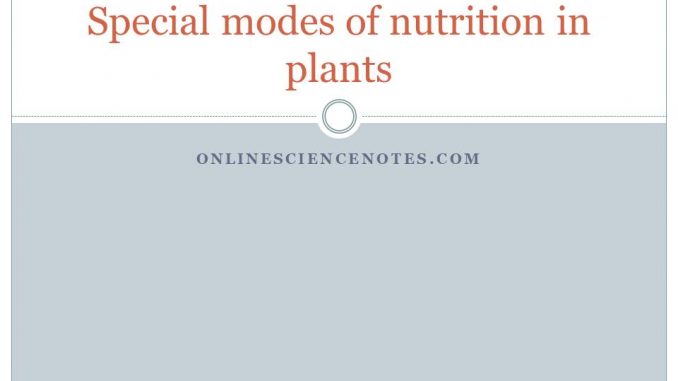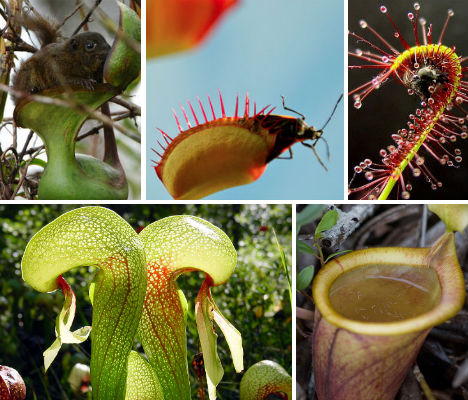
- Plants are autotrophic as they have chlorophyll and can carry out photosynthesis.
- The most important aspect of photosynthesis is the conversion of light energy into chemical energy.
- Plants use carbon dioxide and water in the presence of chlorophyll and sunlight to produce glucose and oxygen.
- Some plants have special devices to obtain their food material and fulfill their nutritional requirement which are categorized as follows:
- Insectivorous plants:
- These are autotrophic plants which grow in nitrogen deficient soil, i.e. bog swamp etc.
- They depend on small insects and hence kill them for their nitrogen requirement.
- The leaves of such plants are modified in various ways for capturing insects such as:
- Nepenthes (Pitcher plant):
- It is a climber with a modified pitcher.
- The pitcher contains number of nectiferous glands which secrete acidic fluid.
- The insects slip down the pitcher in search of nectar where they are finally digested by the digesting enzymes.
- Utricularia (Bladdderwort):
- It is an aquatic plant.
- The leaflets are modified into small bladders which are provided with a trap door entrance.
- The trap door acts as a sort of valve opening only inwards when pushed from outside.
- Very small aquatic animals enter by pushing the trap door.
- The inner surface of the bladder is dotted all over with numerous digestive glands which produce digestive enzymes to digest the dead animals.
- Drosera (Sundew):
- It is a small herb whose upper surface of leaf is covered with numerous tentacles which are sensitive to touch.
- Each gland secretes a sticky fluid which glitters in the sun like dew-drops and hence named ‘sundew’.
- As soon as the insect is trapped, tentacles bend inward and entangle the insect.
- The acidic secretion finally digests the protein and converts into soluble form.
- Dionaea (Venus fly trap):
- This plant consists of leaves with broad teethed lamina having sensory spicules inside them.
- The upper surface of the lamina is thickly covered with reddish digestive glands.
- When the insect is caught, the leaves close suddenly and the glands begin to secrete digestive enzymes.
- Nepenthes (Pitcher plant):

- Root parasites:
Total root parasites: They live parasitically on the roots of other plants.
- Rafflesia: It is a parasite on the roots of figs.
- Orobanche: it is a leafless parasite growing on the roots of mustard, turnip, brinjal (eggplant) etc.
- Balanophora: It is parasitic on the roots of trees.
- Striga: It is parasitic in sugarcane.
Partial root parasites: They grow as partial parasites on the roots of other plants.
Santalum (Sandal wood):
- This plant develops haustoria that enter the roots of the neighboring trees of Dalbergia sisoo (sisau).
- It only absorbs water and minerals from the host.
Thesium: It grows as a partial root parasite on grasses.
3. Stem parasites:
Total stem parasites:
- Cuscuta (Dodder plant) grows as total stem parasite on Citrus, Duranta, Zizyphus
- It has haustorial roots, which derive required materials from the stem of host.
Partial stem parasites:
- They are chlorophyll containing autotrophic plants.
- They depend on the host plant to take water and minerals.
- Loranthus (parasite on mango, Acacia and Dalbergia trees) and Viscum (parasitic on walnut and oak plant)